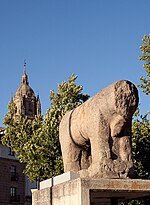Siege of the Salamanca forts

The siege of the Salamanca forts (17–27 June 1812) saw an 800-man Imperial French garrison directed by Lieutenant Colonel Duchemin defend three fortified convents in the city of Salamanca against the 48,000-strong Allied army led by Arthur Wellesley, Lord Wellington. During this time, the French commander Marshal Auguste de Marmont led a 40,000-man French army in an unsuccessful attempt to relieve the garrison. An Allied failure to bring sufficient artillery ammunition caused the siege to be prolonged. The garrison repulsed a premature British attempt to storm the fortified convents on 23 June, but finally surrendered four days later after an artillery bombardment breached one fort and set another one on fire. During his maneuvering, Marmont formed the idea that Wellington was only willing to act on the defensive. This mistaken notion would contribute to Marmont's defeat at the Battle of Salamanca a month later.
Excerpt from the Wikipedia article Siege of the Salamanca forts (License: CC BY-SA 3.0, Authors, Images).Siege of the Salamanca forts
Patio de Escuelas, Salamanca
Geographical coordinates (GPS) Address Nearby Places Show on map
Geographical coordinates (GPS)
| Latitude | Longitude |
|---|---|
| N 40.961612 ° | E -5.667607 ° |
Address
Hospital del Estudio/Rectorado
Patio de Escuelas 1
37008 Salamanca (Centro)
Castile and León, Spain
Open on Google Maps









